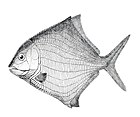| Cosmoptychius Temporal range:
| |
|---|---|
| Scientific classification | |
| Domain: | Eukaryota |
| Kingdom: | Animalia |
| Phylum: | Chordata |
| Class: | Actinopterygii |
| Family: | †Cosmoptychiidae Gardiner, 1963 |
| Genus: | †Cosmoptychius Traquair, 1877 |
| Species: | †C. striatus
|
| Binomial name | |
| †Cosmoptychius striatus (Agassiz, 1835)
| |
| Synonyms | |
| |
Cosmoptychius is an extinct genus of freshwater and estuarine ray-finned fish that lived during the Mississippian epoch.[1][2] It contains a single species, C. striatus from the Visean of Scotland.[3] It has a wide stratigraphic range in the Wardie Shale, with many specimens known.[4][5]
Initially classified as either a palaeonisciform (a now-paraphyletic group of basal actinopterygians)[6] or the earliest stem-group neopterygian, it is now generally considered a stem-group actinopteran.[7]
See also
[edit]References
[edit]- ^ a b Sepkoski, Jack (2002). "A compendium of fossil marine animal genera". Bulletins of American Paleontology. 364: 560. Archived from the original on 2009-02-20. Retrieved 2009-04-24.
- ^ Coates, M. I. (1993). "Actinopterygian and acanthodian fishes from the Viséan of East Kirkton, West Lothian, Scotland". Earth and Environmental Science Transactions of the Royal Society of Edinburgh. 84 (3–4): 317–327. Bibcode:1993EESTR..84..317C. doi:10.1017/S0263593300006131. ISSN 1755-6929.
- ^ "PBDB Taxon". paleobiodb.org. Retrieved 2024-06-18.
- ^ Gardiner, B. G. (1985). "Actinopterygian fish from the Dinantian of Foulden, Berwickshire, Scotland". Earth and Environmental Science Transactions of the Royal Society of Edinburgh. 76 (1): 61–66. doi:10.1017/S0263593300010312. ISSN 1473-7116.
- ^ Dornburg, Alex; Townsend, Jeffrey P.; Friedman, Matt; Near, Thomas J. (2014-08-08). "Phylogenetic informativeness reconciles ray-finned fish molecular divergence times". BMC Evolutionary Biology. 14 (1): 169. Bibcode:2014BMCEE..14..169D. doi:10.1186/s12862-014-0169-0. ISSN 1471-2148. PMC 4236503. PMID 25103329.
- ^ Mickle, Kathryn E. (2012-05-31). Unraveling the Systematics of Palaeoniscoid Fishes--Lower Actinopterygians in Need of a Complete Phylogenetic Revision. University of Kansas (dissertation). p. 488.
- ^ Xu, Guang-Hui; Gao, Ke-Qin; Finarelli, John A. (2014-06-07). "A revision of the Middle Triassic scanilepiform fish Fukangichthys longidorsalis from Xinjiang, China, with comments on the phylogeny of the Actinopteri". Journal of Vertebrate Paleontology. 34 (4): 747–759. Bibcode:2014JVPal..34..747X. doi:10.1080/02724634.2014.837053. ISSN 0272-4634.








Well, that’s interesting to know that Psilotum nudum are known as whisk ferns. Psilotum nudum is the commoner species of the two. While the P. flaccidum is a rare species and is found in the tropical islands. Both the species are usually epiphytic in habit and grow upon tree ferns. These species may also be terrestrial and grow in humus or in the crevices of the rocks.
View the detailed Guide of Psilotum nudum: Detailed Study Of Psilotum Nudum (Whisk Fern), Classification, Anatomy, Reproduction